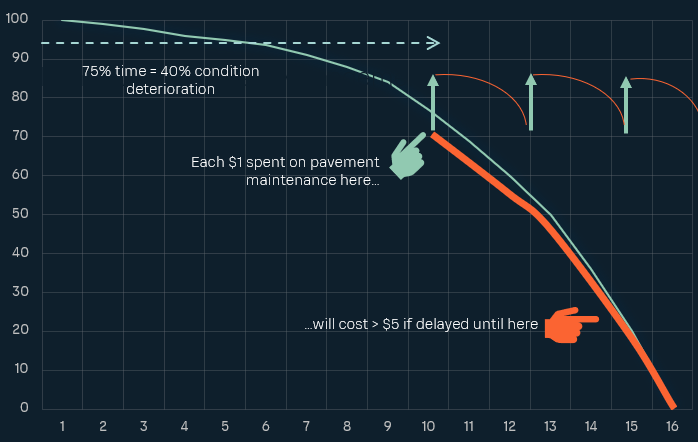Now – if ever – is the time for organizations to embrace more agile road maintenance planning strategies and technologies.
California’s Highway One is famous for its breathtaking views, but since 2023, large sections have been shut down—not for repairs, but because nature reclaimed them. Torrential rains triggered landslides, washing away entire stretches of road. It wasn’t built for this.
New climate, same old playbook
Across the U.S., roads are failing under the pressure of extreme weather. Wyoming’s Highway 22 was washed out by relentless rain. In coastal New Hampshire, rising groundwater is weakening roads from below, making them more prone to collapse. And it’s only getting worse.
A recent article on Bloomberg warns that climate-related road damage in the U.S. will cost an extra $100 billion annually by 2050. Without action, that number could soar to $182 billion by 2090. The problem? Most roads were designed for a climate that no longer exists.
When these roads were built, engineers assumed weather patterns would remain stable. That assumption no longer holds. Atmospheric rivers—once rare phenomena—are now dumping unprecedented amounts of rain on California’s coast, triggering landslides. Record-breaking heatwaves are causing asphalt to buckle. Freeze-thaw cycles are cracking roads faster than we can fix them. The very foundations of our road networks are being tested—and failing.
Road infrastructure worldwide was not designed to withstand the rapidly increasing unpredictability of changing weather patterns. Now more than ever, keeping roads safe and functional depends on proactive, preventive maintenance—but too many public works organizations remain stuck with outdated, inefficient practices.
For decades, managing road conditions has been a slow, expensive, and reactive process. Most cities rely on labor-intensive surveys conducted only once every few years—often outsourced to specialized agencies using costly laser scanners. These manual assessments cover only a fraction of the network at a time, leaving large sections unsurveyed or relying on years-old data that no longer reflects reality.
Now – if ever – is the time for organizations to embrace more agile maintenance planning strategies and technologies. Instead of relying on outdated inspection schedules and costly outsourcing, transportation agencies need continuous, reliable, and cost-effective inspection methods to anticipate issues before they escalate. The ability to detect early signs of deterioration—such as subtle cracks, erosion risks, or underground weakening—allows for targeted, cost-effective interventions rather than expensive emergency rebuilds.
A solid preventative road maintenance approach is something any organization can transition to by focusing on several key areas:
Ensuring access to recent, reliable road condition data
Even without large budgets , real-time, accurate road condition data can be collected with computer vision-powered solutions—no expensive, specialized hardware or outsourcing required.
Having recent, reliable data always at hand allows road crews to respond proactively, preventing minor issues from becoming major failures.
Predicting risks before they become failures
Analyzing weather patterns, soil conditions, and traffic loads can help forecast where roads are likely to deteriorate.
Early warnings allow for timely interventions, saving costs and reducing disruptions.
Adapting materials and designs to a changing climate
Roads in different climates need tailored solutions—heat-resistant asphalt in desert regions, reinforced drainage in flood-prone areas.
Data-driven insights help engineers choose the right materials for long-term durability.
Maximizing repair budgets through smart prioritization
With limited resources, cities and states need to focus on the most urgent repairs first.
A data-driven approach ensures funds go where they’re needed most, reducing expensive emergency fixes.
The road ahead
Highway One’s destruction is a wake-up call. Roads built decades ago can’t handle today’s climate, and without smarter maintenance strategies, infrastructure will continue to fail. To stay ahead, transportation agencies must shift from reactive repairs to continuous monitoring and proactive intervention.
On top of the critical safety aspect, the financial implications are also staggering. If governments continue to rebuild roads only after they fail, costs will balloon. However, preemptive strategies—like collecting continuous road condition data and adjusting materials to withstand changing weather—could dramatically reduce long-term expenses.

Early intervention asset management. Source: Federal Highway Administration
The way we build and maintain roads must change. By investing in real-time data collection and predictive analysis, we can keep roads safer, reduce repair costs, and ensure that communities remain connected—no matter how the climate changes.

